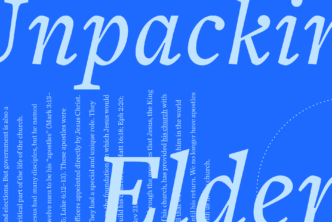Is one Bible version enough for good Bible study, and if not, how is a person supposed to know how to choose a good Bible translation?
An experienced pastor I greatly respect, a truly world-class Bible expositor whose series through Ephesians changed my life, sat in a room with a bunch of skinny, exegetically deficient young preacher wannabes. I was the skinniest. He was trying to mentor our motley crew, providing one piece of wisdom after another, pieces I have always, by God’s grace, followed.
Except one. This pastor told us young men to get one Bible and stick with it. His point was not so much to stick with one translation (he himself checked multiple translations regularly) but to have one edition that you really get to know.
Having just one physical copy of the Bible aids memory, because it’s where you spend all your Bible reading and study time. The very place on the page where certain verses lie becomes coded in your kinesthetic memory and even helps it along, providing visual and tactile aids to the brain. By having just one translation and one edition, you work that Bible as deeply into your thinking as it can go.
And when an entire church, or group of churches, or even an entire nation of Christians, uses basically one Bible translation, genuinely wonderful things happen. An individual Christian’s knowledge of the Bible increases almost by accident, because certain phrases become woven into the language of the community. Christians are constantly reinforcing each other’s knowledge of the Bible every time they mention it in conversation. There is great value in having a common standard.
Quite obviously, the KJV served as that standard in English-speaking lands for a good 300 years.
And this common standard is a value we have lost. It may not be gone forever, but barring some cataclysmic event I can’t foresee, it is gone for your lifetime and mine. English-speaking Christianity is too fractured, too tribalized.
I have been called to serve all Christian tribes with my writing. The lack of an accepted standard means I simply cannot become master of one Bible translation and one Bible edition. I have to check all the good ones all the time, because I write for groups who use them.
I did not follow my mentor’s advice. Even he, for various reasons, had to give up the Bible edition he’d had for decades and use a different translation. Through no fault of his own, he had to start fresh at age 46. This is what happens when the common standard falls away.
We can and should lament what we’ve lost.
Guidelines for how to choose a good Bible translation
But I am perfectly convinced that we should also rejoice in what we have gained. Many, many other cultures do not have this amazingly good problem we have: so many quality Bible translations, available in quality print and digital formats, with notes and study aids and audio Bibles and apps! It has never been easier for English-speaking people who love the Bible to find and use excellent Bible study tools. And the very best tools I know for studying the Bible are good Bible translations.
Figuring out how to choose a good Bible translation can be tricky. Here are five ways, drawn directly from my own experience, that I think the proliferation of (good) Bible translations can help you—or help you help others.
1. Use the NIrV for struggling readers
I had the privilege of teaching almost every Sunday morning for six years in an outreach ministry to impoverished, functionally illiterate adults. Which translation is best for teaching the Bible in that setting? These folks listened well to the Bible, but they choked on the KJV, NASB, and even the ESV. They simply got lost in all the verbiage, and I don’t blame them. (I could tell specific stories, some of them quite funny.)
For such an audience, I recommend using the New International Reader’s Version. It was perfect for my adult class. The shorter sentences were a huge aid to the public reading of Scripture I was always doing. The NIrV also restates the subject of a sentence rather than using a pronoun; this alone was fantastically helpful. I preached through Romans, the Sermon on the Mount, and the entire Old Testament (hitting the high points), and all along the NIrV allowed me to explain the Bible rather than being forced to explain the English.
2. Use a more literal translation for close textual analysis
I once taught a small Sunday school class for young parents in which, because we were in a college town, there were eight—count them—PhDs or PhD students. More literal translations were best suited for that group, as well as for the study in which we were engaged. We were parsing some fine distinctions in the text, and I needed ambiguities to remain rather than be decided by an interpretive translation. It’s awkward to have to disagree with the Bible translation from which you’re teaching (though it’s also a good thing to do every so often, just to keep your listeners from assuming that a given translation is perfect).
I am very open to disagreement on this point, but for most truly “expository” Bible teaching of literate adults—the kind of teaching that really digs into Scripture—I think you’ll find that a more literal translation, such as the ESV or NASB, is the best tool.
3. Use whatever is on hand for evangelism/counseling, but turn to a centrist translation if you can
I once sat on the floor of a gym talking to a twelve-year-old camper at a Christian camp late one summer. Because of certain sensitivities on the part of the camp constituency, we counselors were asked to use the KJV. This kid had spiritual questions but no church background, and I’ll never forget the look he gave me when I dutifully read passages to him from the KJV. Utter confusion. So I broke the camp rule. I felt the spirit of the law was more important. I was called to explain the Bible to this kid, not to teach him Jacobean English. I pulled out the pocket NASB I had for my own reading.
I’m not sure the NASB was much better in this case, but it at least had the advantage of sounding like PBS instead of like Shakespeare. If I had had my druthers (I left them at home by accident), I would have pulled out the NIV or the HCSB. Perhaps you have found, as I have, that one of the best things you can do in evangelism or counseling is to ask people to read the Bible in your hand for themselves. This way they can see that you’re not making up what you’re saying. You can focus instead on what God says. Such a conversation—on the bus, on a plane, in a park, at a store—is not the place for expository-level textual analysis. You want simple, clear English and a minimum of interpretive difficulty. You want the NIV or HCSB.
4. Use a reader’s edition and a centrist or dynamic translation for reading big chunks of Scripture
I took several classes in college in which I was required to do a fair bit of Bible reading. For reading big chunks of Bible text at a time, I like the smoother path provided by the centrist and dynamic translations. (I also like to read Bible editions stripped of their chapter and verse numbers—this facilitates reading big chunks. This can be done with visual filters in Logos.) The NIV or NLT may be good here.
5. Use whatever (good) translation someone hands you
Sometimes the justifications for the use of a particular translation are not spiritual at all but financial or prudential. And that’s okay too. The SBC produced the HCSB, an excellent translation, in part because they print millions of pages of Sunday school material and they wanted to have their own Bible translation. Officially, “Broadman & Holman favored having our own translation in order to make the publication of Bibles simpler and more practical” (Loc. 124). I have also heard, though I have failed to substantiate this, that they wanted to avoid paying royalties on other Bible translations. What’s wrong with wanting to be a better steward of funds entrusted to you by the Lord?
If someone you trust hands you a translation and says, “This is what we’re using,” then use it. (If you’re truly fearful that the translation you were handed is not good, talk to your pastor.) You may not have a choice if you’re a children’s ministry leader or a copy editor at a Christian publishing house or the mother of a child in Christian school. Someone else will be choosing a Bible translation for you. Don’t despair. Don’t lament. Make the best of a great situation.
Conclusion
There is general agreement in the evangelical biblical studies community about the character and value of the respective major Bible translations. It isn’t hard to learn what that value is, and years of using the translations will tend to confirm and deepen your understanding of their unique characters. Once you do, you can see the existence of multiple Bible translations as an aid rather than a threat. You can stop wondering how to choose a good Bible translation or asking “What’s the best Bible translation?” and start asking, “What’s the most useful Bible translation for this particular circumstance?” No tribalism necessary.
Related articles
- When 2 Bible Translations Disagree, Which One Is Right?
- What a 400-Year-Old Bible Preface Can Teach Us about Translations
- Why 10 Translations May Be Better Than 1 Greek (or Hebrew) Bible
- Which Bible Translation Is Best? All the Good Ones.
- 3 Reasons Preachers Shouldn’t Publicly Contradict a Bible Translation
Related resources
***






